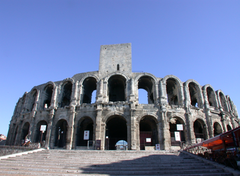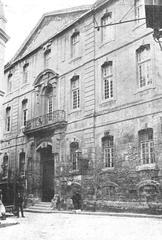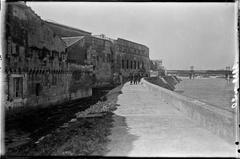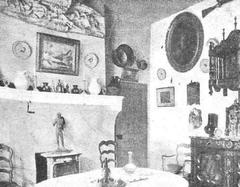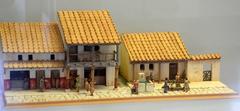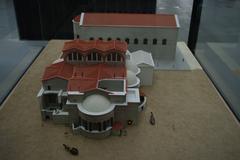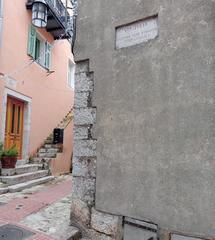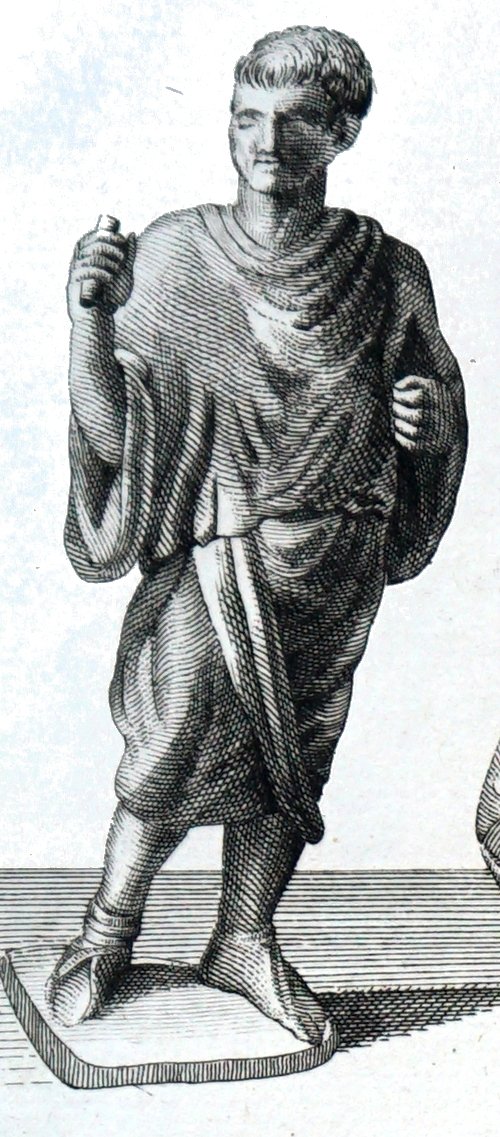
Visiting Arles: Roman and Romanesque Monuments – Guide, Tickets, Hours, and Top Attractions
Date: 14/06/2025
Introduction
Arles, nestled along the Rhône River in the heart of Provence, stands as a living testament to the grandeur of Roman civilization and the artistry of the Romanesque era. With its impressive ensemble of UNESCO-listed monuments—including the monumental amphitheatre, ancient theatre, cryptoporticus, baths, and the Romanesque Saint-Trophime—Arles offers visitors an immersive journey through over two millennia of history. This guide delivers essential insights on Arles’ historical evolution, practical details for visiting, and expert tips to help you make the most of your trip.
Table of Contents
- Historical Background
- Visitor Information
- Main Monuments and Sites
- Practical Travel Information
- FAQs
- Conclusion and Further Resources
Historical Background
Pre-Roman Origins
Arles’ history begins long before the Romans, with Ligurian settlements and later Celtic influence. Known as Theline and then Arelate (meaning “surrounded by swamps”), its strategic location on the Rhône made it a vital trading point, interacting with Greek Marseille (marvellous-provence.com).
Roman Conquest and Urban Growth
In 123 BCE, the Romans annexed the area, integrating Arles into their province of Gaul (france-voyage.com). The city gained prominence by siding with Julius Caesar in the civil wars, receiving privileges that spurred rapid development. By the 1st century BCE, Arles had become one of the most significant cities in Roman Gaul, second only to Lyon (arles-guide.com).
Building the Roman Monuments
Roman Arles flourished with the construction of grand monuments, many of which endure today:
- Amphitheatre (Arènes d’Arles): Built around 90 CE, it seated over 20,000 and was modeled after Rome’s Colosseum (ancient-origins.net).
- Roman Theatre: Erected in the late 1st century BCE, this venue was central to cultural life and the discovery site of the famous “Venus of Arles” (britannica.com).
- Cryptoporticus: Subterranean galleries supporting the ancient forum (touristlink.com).
- Baths of Constantine: Dating to the 4th century CE, reflecting the city’s continued prominence (france-voyage.com).
- Alyscamps Necropolis: A vast Roman burial ground later revered as a Christian cemetery (travelingwithsweeney.com).
Medieval Transformations
Following Rome’s decline, Arles endured invasions and became the capital of the Kingdom of Arles in the 10th century (britannica.com). The amphitheatre was converted into a fortified enclave, housing dwellings and churches to shelter residents during turbulent times (ancient-origins.net).
Romanesque Revival: Saint-Trophime
The 11th–12th centuries saw a cultural revival, epitomized by the construction of the Romanesque Saint-Trophime Church and its cloister. Situated on a key pilgrimage route, the church’s sculpted portal and cloister are masterpieces of Provençal Romanesque art (arles-guide.com; travelingwithsweeney.com).
Modern Rediscovery and UNESCO Recognition
Interest in Arles’ antiquities was renewed in the 18th–19th centuries. Restoration and preservation efforts, led by figures like Prosper Mérimée, returned the amphitheatre and other monuments to public use (ancient-origins.net). In 1981, Arles’ Roman and Romanesque monuments were inscribed as a UNESCO World Heritage Site (UNESCO), ensuring their protection and ongoing significance.
Visitor Information
Hours, Tickets, and Passes
- Amphitheatre: Open daily, generally 9:30–19:00 (last entry 45 min before closing; check for seasonal changes).
- Roman Theatre: Open daily, typically 9:30–19:00.
- Saint-Trophime Church: Free entry (unless during services); cloister ticketed, usually open 9:30–18:00.
- Cryptoporticus and Baths: Open 9:30–18:00; Alyscamps open during daylight hours.
- Combined Passes: The “Advantage Pass” (~€19) grants access to multiple sites; individual tickets €6–€10.
- Discounts: Available for students, seniors, and children; children under 18 often free.
- Online Booking: Strongly recommended during peak seasons (Nomads Travel Guide).
Accessibility and Travel Tips
- Major monuments are centrally located and walkable, but some have uneven surfaces. Wheelchair access is available at selected sites—consult the Tourist Office for details.
- Guided and audio tours provide enriching context. Early morning or late afternoon visits are best for avoiding crowds and enjoying optimal lighting.
- Festivals and events often affect monument hours; check local schedules in advance.
Main Monuments and Sites
Arles Amphitheatre (Arènes d’Arles)
- Visiting Hours: 9:30–19:00 (seasonal variations)
- Tickets: Included in multi-site passes or available individually
The amphitheatre, Arles’ most iconic monument, showcases Roman engineering and remains a vibrant venue for events such as bullfights and concerts (UNESCO; The Crazy Tourist). Climb to the upper tiers for panoramic city views.
Roman Theatre
- Visiting Hours: 9:30–18:00
- Tickets: Multi-site pass or individual entry
Once seating 8,000 spectators, the theatre hosts modern performances and offers a glimpse into Arles’ cultural past (The Travelling Surveyor).
Cryptoporticus
- Visiting Hours: Accessed via Hôtel de Ville during city hall hours
This network of subterranean galleries supported the Roman forum and is a fascinating site for history enthusiasts.
Baths of Constantine
- Visiting Hours: 9:30–17:30
Among France’s best-preserved Roman baths, showcasing ancient heating systems (UNESCO).
Alyscamps Necropolis
- Visiting Hours: Open daily; best visited during daylight
A prestigious burial site from Roman through medieval times, also visited by Van Gogh and Gauguin (Brainy Backpackers).
Saint-Trophime Church and Cloister
- Visiting Hours: Church free; cloister ticketed
A masterpiece of Romanesque sculpture and architecture (UNESCO).
Other Notable Sites
- Obelisk: 4th-century granite monument on Place de la République (Offbeat France).
- Remains of the Roman Circus: Visit Musée Départemental Arles Antique for related artifacts.
- Forum Square (Place du Forum): The ancient city center, now lively with cafés and famously painted by Van Gogh.
Practical Travel Information
Getting to and Around Arles
- By Train: Frequent SNCF TER and some TGV service from Avignon, Nîmes, Marseille (SNCF Connect, Trainline).
- By Car: Access via A54 motorway; public parking in and around the city center.
- By Bus: Regional Envia network connects nearby towns.
- On Foot: Historic center is compact and easily walkable.
- By Bicycle: Rentals available; best for exploring the Rhône riverbanks and Camargue (Nomads Travel Guide).
Accommodation and Dining
- City Center: Classic hotels like Hôtel Musée and Hôtel Jules César; book early in festival season (Explore Your Bucket List).
- Budget Options: Hostels and affordable hotels near the station.
- Dining: Provençal and Mediterranean cuisine at local favorites like Restaurant Le Constantin; visit Café Van Gogh for a slice of art history.
- Markets: Enjoy fresh local produce at Arles Market (Wednesdays and Saturdays) (GPSmyCity).
Safety and Useful Tips
- Arles is generally safe; use standard precautions in crowded places.
- Bring sun protection in summer and layers in winter.
- Dress modestly when visiting religious sites.
- Travel insurance is recommended (Travel France Blog).
- Wear comfortable shoes for cobblestone streets.
Frequently Asked Questions (FAQ)
Q: When are the major monuments open?
A: Most are open 9:30–19:00 in summer, with shorter hours in winter. Confirm individual sites, especially during events.
Q: How do I buy tickets or passes?
A: Tickets and passes are available online, at the Arles Tourist Office, or at each monument.
Q: Are guided tours available?
A: Yes, via the Tourist Office and private guides. Self-guided tours with apps and downloadable maps are also popular.
Q: Is Arles accessible for wheelchair users?
A: Some sites offer accessibility; others, particularly ancient monuments, have limited access. Consult the Tourist Office for details.
Q: What’s the best time to visit?
A: Spring and autumn for pleasant weather and fewer crowds; summer for festivals but expect heat.
Conclusion
Arles offers a rich tapestry of history, art, and Provençal culture. Its Roman and Romanesque monuments are not just relics—they remain active venues for festivals, art, and communal life. With thoughtful planning—consulting visiting hours, securing tickets, and leveraging local resources—visitors can enjoy an immersive journey through time.
Download the Audiala app for curated tours and real-time tips, and follow Arles’ official tourism channels for the latest news.


